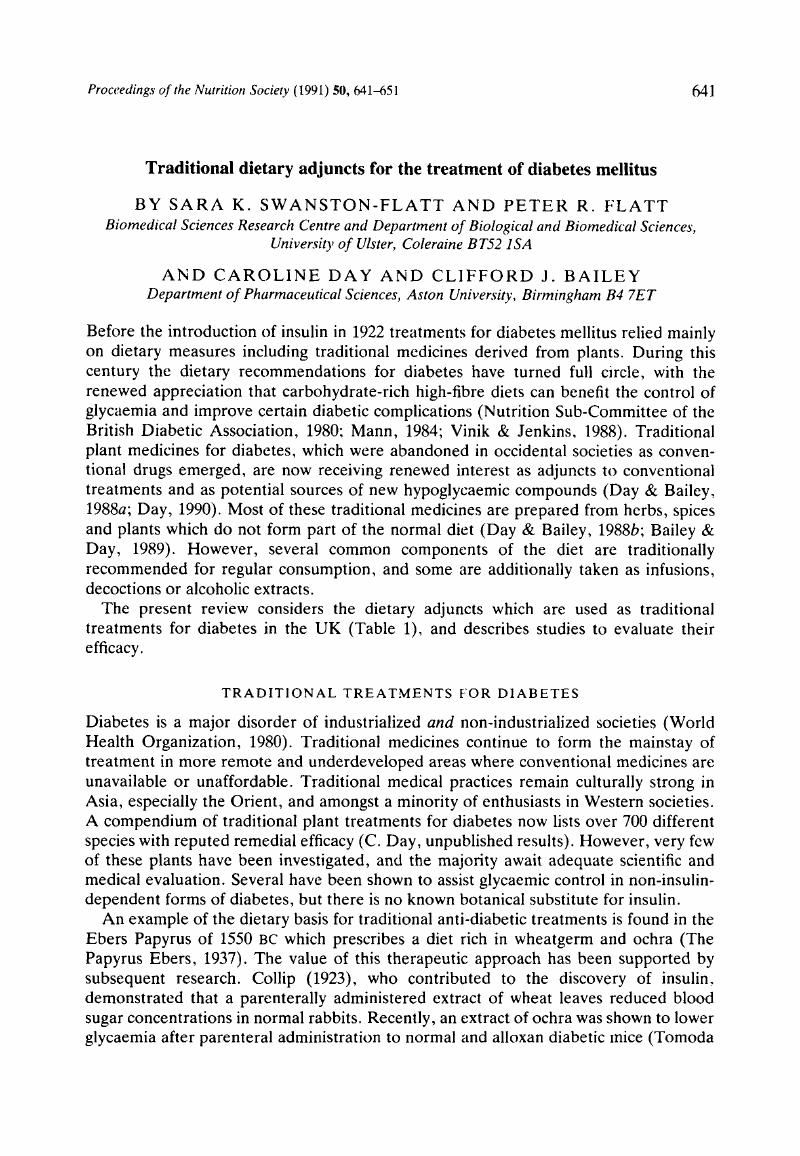Crossref Citations
This article has been cited by the following publications. This list is generated based on data provided by Crossref.
Platel, Kalpana
and
Srinivasan, K.
1995.
Effect of dietary intake of freeze dried bitter gourd (Momordica charantia) in streptozotocin induced diabetic rats.
Food / Nahrung,
Vol. 39,
Issue. 4,
p.
262.
Day, Caroline
1995.
Hypoglycaemic plant compounds.
Practical Diabetes International,
Vol. 12,
Issue. 6,
p.
269.
Raman, A.
and
Lau, C.
1996.
Anti-diabetic properties and phytochemistry of Momordica charantia L. (Cucurbitaceae).
Phytomedicine,
Vol. 2,
Issue. 4,
p.
349.
Gray, Alison M.
and
Flatt, Peter R.
1997.
Nature's own pharmacy: The diabetes perspective.
Proceedings of the Nutrition Society,
Vol. 56,
Issue. 1B,
p.
507.
Platel, Kalpana
and
Srinivasan, K.
1997.
Plant foods in the management of Diabetes mellitus: Vegetables as potential hypoglycaemic agents.
Food / Nahrung,
Vol. 41,
Issue. 2,
p.
68.
Day, Caroline
1998.
Traditional plant treatments for diabetes mellitus: pharmaceutical foods.
British Journal of Nutrition,
Vol. 80,
Issue. 1,
p.
5.
Gray, Alison M.
and
Flatt, Peter R.
1998.
Actions of the traditional anti-diabetic plant,Agrimony eupatoria(agrimony): effects on hyperglycaemia, cellular glucose metabolism and insulin secretion.
British Journal of Nutrition,
Vol. 80,
Issue. 1,
p.
109.
Gray, Alison M.
and
Flatt, Peter R.
1999.
Insulin-releasing and insulin-like activity of the traditional anti-diabetic plantCoriandrum sativum(coriander).
British Journal of Nutrition,
Vol. 81,
Issue. 3,
p.
203.
Gray, Alison M.
Abdel-Wahab, Yasser H.A.
and
Flatt, Peter R.
2000.
The Traditional Plant Treatment, Sambucus nigra (elder), Exhibits Insulin-Like and Insulin-Releasing Actions In Vitro.
The Journal of Nutrition,
Vol. 130,
Issue. 1,
p.
15.
2000.
The Cambridge World History of Food.
p.
739.
Lieberman, Leslie Sue
2000.
The Cambridge World History of Food.
p.
1078.
Gallagher, A.M
Flatt, P.R
Duffy, G
and
Abdel-Wahab, Y.H.A
2003.
The effects of traditional antidiabetic plants on in vitro glucose diffusion.
Nutrition Research,
Vol. 23,
Issue. 3,
p.
413.
Ribnicky, David M.
Poulev, Alexander
O'Neal, Joseph
Wnorowski, Gary
Malek, Dolores E.
Jäger, Ralf
and
Raskin, Ilya
2004.
Toxicological evaluation of the ethanolic extract of Artemisia dracunculus L. for use as a dietary supplement and in functional foods.
Food and Chemical Toxicology,
Vol. 42,
Issue. 4,
p.
585.
Srinivasan, K.
2005.
Plant foods in the management of diabetes mellitus: Spices as beneficial antidiabetic food adjuncts.
International Journal of Food Sciences and Nutrition,
Vol. 56,
Issue. 6,
p.
399.
Moghaddam, M.S.
Kumar, P. Anil
Reddy, G. Bhanuprakash
and
Ghole, V.S.
2005.
Effect of Diabecon on sugar-induced lens opacity in organ culture: mechanism of action.
Journal of Ethnopharmacology,
Vol. 97,
Issue. 2,
p.
397.
Al-Amin, Zainab M.
Thomson, Martha
Al-Qattan, Khaled K.
Peltonen-Shalaby, Riitta
and
Ali, Muslim
2006.
Anti-diabetic and hypolipidaemic properties of ginger ( Zingiber officinale) in streptozotocin-induced diabetic rats.
British Journal of Nutrition,
Vol. 96,
Issue. 04,
p.
660.
Logendra, Sithes
Ribnicky, David M.
Yang, Hui
Poulev, Alexander
Ma, Jun
Kennelly, Edward J.
and
Raskin, Ilya
2006.
Bioassay-guided isolation of aldose reductase inhibitors from Artemisia dracunculus.
Phytochemistry,
Vol. 67,
Issue. 14,
p.
1539.
Ribnicky, D.M.
Poulev, A.
Watford, M.
Cefalu, W.T.
and
Raskin, I.
2006.
Antihyperglycemic activity of Tarralin™, an ethanolic extract of Artemisia dracunculus L..
Phytomedicine,
Vol. 13,
Issue. 8,
p.
550.
Mathews, Jacqueline N.
Flatt, Peter R.
and
Abdel-Wahab, Yasser H.
2006.
Asparagus adscendens(Shweta musali) stimulates insulin secretion, insulin action and inhibits starch digestion.
British Journal of Nutrition,
Vol. 95,
Issue. 3,
p.
576.
Govorko, Dmitry
Logendra, Sithes
Wang, Yanxin
Esposito, Debora
Komarnytsky, Slavko
Ribnicky, David
Poulev, Alexander
Wang, Zhong
Cefalu, William T.
and
Raskin, Ilya
2007.
Polyphenolic compounds fromArtemisia dracunculus L.inhibit PEPCK gene expression and gluconeogenesis in an H4IIE hepatoma cell line.
American Journal of Physiology-Endocrinology and Metabolism,
Vol. 293,
Issue. 6,
p.
E1503.



